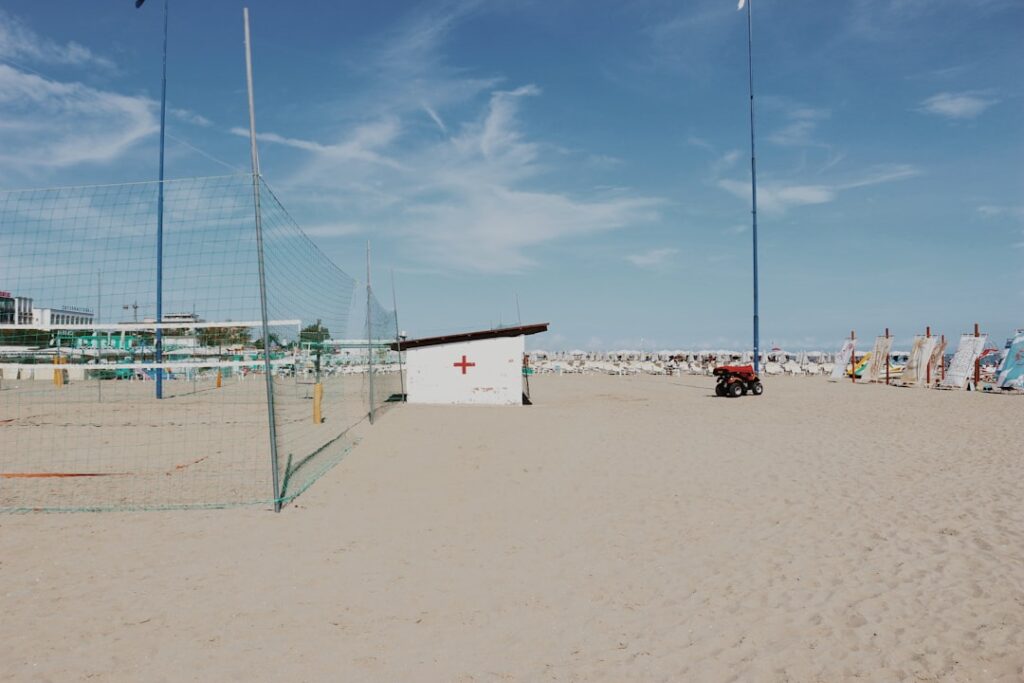Beach volleyball, a sport that combines athleticism, strategy, and the sun-soaked ambiance of sandy shores, has gained immense popularity since its inception. Originating in California during the 1920s, it has evolved into a global phenomenon, captivating audiences and players alike. The sport is characterized by its fast-paced nature and the unique challenges posed by playing on sand, which requires a different skill set compared to traditional indoor volleyball.
With its roots deeply embedded in beach culture, beach volleyball not only serves as a competitive sport but also as a social activity that brings people together. The allure of beach volleyball lies not only in its competitive spirit but also in the vibrant atmosphere it creates. Players often find themselves surrounded by the sound of crashing waves and the warmth of the sun, making each match an exhilarating experience.
The sport has also become a staple in international competitions, including the Olympics, where it showcases the talents of athletes from around the world. As more people are drawn to the sport, understanding its nuances becomes essential for both aspiring players and enthusiastic spectators.
Key Takeaways
- Beach volleyball is a fast-paced and exciting sport played on sand by two teams of two players each.
- The court is smaller than indoor volleyball, and players wear swimsuits and bare feet to play.
- Scoring is based on rally point system, with matches typically played as best of three sets.
- Proper serving techniques include the overhand and underhand serve, with the goal of putting pressure on the opposing team.
- Passing and setting fundamentals are crucial for successful plays, requiring good communication and teamwork between players.
Understanding the Court and Equipment
The beach volleyball court is distinctively different from its indoor counterpart, primarily due to its dimensions and surface. A standard beach volleyball court measures 16 meters long and 8 meters wide, with a net height of 2.43 meters for men and 2.24 meters for women. The sand surface adds an extra layer of complexity, as players must adapt their movements to the softer ground, which can be both challenging and rewarding.
The court is typically marked with boundary lines, and the area surrounding it is often left open to accommodate spectators and provide a festive atmosphere. In terms of equipment, beach volleyball players utilize a specially designed ball that is slightly larger and lighter than indoor volleyballs. This design allows for better handling in outdoor conditions, where wind and weather can significantly impact gameplay.
Players also wear appropriate attire, usually consisting of swimsuits or athletic wear that allows for freedom of movement while providing comfort in warm weather. The right footwear is also crucial; many players opt to play barefoot to enhance their connection with the sand, while others may choose specialized sand socks for added protection.
Basic Rules and Scoring

Understanding the basic rules and scoring system of beach volleyball is essential for anyone looking to engage with the sport. Matches are typically played in a best-of-three format, with teams competing to win two sets. Each set is played to 21 points, but a team must win by at least two points.
If a third set is necessary, it is played to 15 points, again requiring a two-point margin for victory. This scoring system encourages intense competition and strategic play, as teams must balance aggressive tactics with careful defense. In addition to scoring, players must adhere to specific rules regarding player rotations and substitutions.
Each team consists of two players who must work together seamlessly to cover the court effectively. Unlike indoor volleyball, there are no designated positions; players must be versatile and capable of performing various roles throughout the match. Understanding these fundamental rules not only enhances gameplay but also fosters a deeper appreciation for the sport’s intricacies.
Proper Serving Techniques
| Technique | Description |
|---|---|
| Clearing the Table | Removing used dishes and utensils from the table in a timely and efficient manner. |
| Plating | Arranging food on plates in an attractive and appetizing manner. |
| Carrying Plates | Transporting plates from the kitchen to the table without spilling or dropping the food. |
| Tableside Service | Providing personalized service to guests at the table, such as carving meat or preparing salads. |
Serving is one of the most critical skills in beach volleyball, as it sets the tone for each rally. A well-executed serve can put immediate pressure on the opposing team, while a poorly executed one can lead to easy points for them. There are several serving techniques players can employ, including the underhand serve, overhand serve, and jump serve.
Each technique has its advantages and can be used strategically depending on the situation. The overhand serve is often favored for its power and potential to disrupt the opponent’s formation. To execute this serve effectively, players should focus on their toss and follow-through.
A consistent toss allows for better timing and accuracy, while a strong follow-through ensures that the ball travels at high speed over the net. Practicing this technique regularly can significantly improve a player’s serving game, making it an essential component of their overall skill set.
Passing and Setting Fundamentals
Passing and setting are foundational skills in beach volleyball that require precision and teamwork. The pass is typically the first touch after a serve or attack from the opposing team, and it sets up the opportunity for an effective attack. Players must position themselves correctly to receive the ball cleanly, using their forearms or hands to direct it toward their teammate.
A successful pass allows for a smooth transition into setting, where one player delivers the ball to an attacker. Setting is an art form in itself; it requires not only technical skill but also an understanding of timing and player positioning. The setter must be aware of their teammates’ movements and anticipate where they will be when the ball arrives.
A good set should be high enough for an attacker to jump and hit effectively while also being placed in a position that maximizes scoring potential. Mastering these fundamentals can significantly elevate a player’s performance on the court.
Hitting and Spiking Techniques

Hitting and spiking are crucial offensive maneuvers in beach volleyball that can determine the outcome of a match. A well-executed spike can be a game-changer, allowing teams to score points quickly and decisively. To perform an effective spike, players must focus on their approach, timing, and follow-through.
The approach typically involves three quick steps toward the net, allowing players to generate momentum before jumping. Timing is essential when executing a spike; players must jump at just the right moment to connect with the ball at its highest point. This requires practice and coordination with the setter to ensure that they are in sync during gameplay.
Once airborne, players should aim to hit the ball with their dominant hand while keeping their body aligned for maximum power and accuracy. A strong follow-through not only enhances the speed of the ball but also helps maintain balance upon landing.
Defensive Strategies and Positioning
Defensive strategies in beach volleyball are vital for countering opponents’ attacks and maintaining control of the game. Given that each team consists of only two players, effective positioning becomes crucial in covering the court adequately. Players must communicate constantly to ensure they are both aware of their responsibilities during rallies.
This often involves one player taking on a more aggressive role while the other focuses on defense. One common defensive strategy is known as “reading” the opponent’s body language and positioning before they hit the ball. By anticipating where an attack might go based on subtle cues from the hitter, defenders can position themselves accordingly to make a successful dig or block.
Additionally, practicing various defensive formations can help teams adapt to different opponents’ styles of play, enhancing their overall effectiveness on the court.
Communication and Teamwork
Communication is paramount in beach volleyball; with only two players on each team, clear dialogue can make all the difference between victory and defeat. Players must develop a strong rapport both on and off the court to foster effective teamwork during matches. This includes verbal cues as well as non-verbal signals that indicate intentions during play.
Establishing roles within the team can also enhance communication; one player may take on more responsibility for setting while the other focuses on hitting or defense. By clearly defining these roles, teams can streamline their strategies and improve their overall performance during matches. Regular practice sessions that emphasize communication drills can further strengthen this vital aspect of gameplay.
Tips for Improving Your Game
Improving one’s game in beach volleyball requires dedication and practice across various skill sets. One effective tip is to focus on conditioning; given that beach volleyball demands agility, strength, and endurance, incorporating fitness routines that enhance these attributes can lead to significant improvements on the court. Exercises such as sprinting on sand or agility drills can help players develop better footwork and speed.
Another valuable tip is to study professional matches or attend local tournaments to observe advanced techniques in action. Watching experienced players can provide insights into effective strategies, positioning, and teamwork that may not be immediately apparent during practice sessions. Additionally, seeking feedback from coaches or more experienced players can help identify areas for improvement and refine skills over time.
Common Mistakes to Avoid
As with any sport, there are common mistakes that players should strive to avoid in beach volleyball. One frequent error is neglecting proper footwork; many players underestimate how crucial foot placement is when receiving serves or setting up for spikes. Poor footwork can lead to missed opportunities or ineffective plays that hinder overall performance.
Another common mistake involves failing to communicate effectively with teammates during matches. Silence on the court can lead to confusion about roles or responsibilities during rallies, resulting in missed plays or defensive lapses. Players should prioritize open communication throughout matches to ensure they are always on the same page.
Conclusion and Next Steps
In conclusion, beach volleyball offers an exciting blend of athleticism, strategy, and camaraderie that appeals to players of all skill levels. By understanding the fundamentals of the game—from court dimensions and equipment to advanced techniques like hitting and defensive strategies—players can enhance their performance while enjoying this dynamic sport. As they continue their journey in beach volleyball, aspiring athletes should focus on consistent practice, effective communication with teammates, and a commitment to improving their skills.
For those looking to take their game further, participating in local leagues or tournaments can provide invaluable experience while fostering connections within the beach volleyball community. Whether playing casually or competitively, embracing the spirit of teamwork and dedication will undoubtedly lead to growth both as individuals and as part of a cohesive unit on the sand.
If you’re diving into the world of beach volleyball and eager to master the basics in just a day, it’s essential to consider the importance of proper recovery after an intense session on the sand. A related article that might interest you is about finding the best recovery sandals for arch support and pain relief. This piece provides valuable insights into selecting footwear that can help alleviate discomfort and support your feet after a day of beach volleyball. For more information, check out the article on how to find the best recovery sandals for arch support and pain relief.
FAQs
What are the basic rules of beach volleyball?
Beach volleyball is played with two teams of two players each. The objective is to score points by hitting the ball over the net and onto the opponent’s side of the court. Each team is allowed a maximum of three touches to return the ball, and the rally continues until the ball hits the ground or goes out of bounds.
What are the key skills needed for beach volleyball?
Key skills for beach volleyball include serving, passing, setting, attacking, blocking, and digging. Players also need to have good communication, teamwork, and agility to move quickly on the sand.
What is the court size for beach volleyball?
A beach volleyball court is 16 meters long and 8 meters wide, with a net in the middle that is 2.43 meters high for men and 2.24 meters high for women.
What is the difference between beach volleyball and indoor volleyball?
Beach volleyball is played on sand with two players per team, while indoor volleyball is played on a hard court with six players per team. The rules and skills are similar, but the dynamics of the game are different due to the playing surface and team size.
What are the basic strategies for beach volleyball?
Basic strategies for beach volleyball include serving aggressively, communicating with your partner, positioning yourself well on the court, and being able to adapt to different playing conditions such as wind and sun. It’s also important to anticipate your opponent’s moves and make quick decisions during the game.





